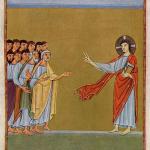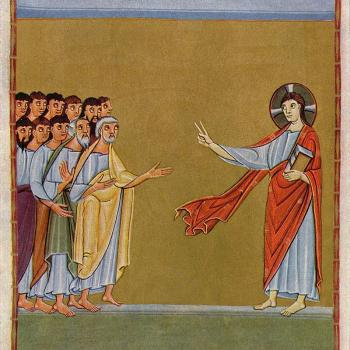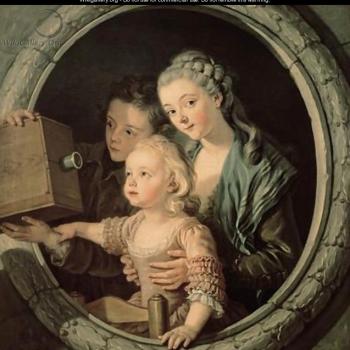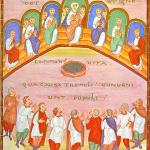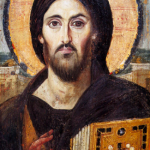In my particular series of historical blog posts (Heck of a Ride Around the Sun) I have tried to include and insert many many canonized Catholic Saints, Blesseds, Venerables and Servants of God into the timelines. I may have missed some and it’s hard to go back and drop them into history. So I’m putting them here in this particular series of articles on the Catholic Bard’s List of Saints.
I took the General Roman Calendar, some books on saints such as…

to make these timelines.
If you didn’t see your favorite saint listed, it’s because I can’t list everyone. I would have to create a website just for that purpose. But of course that has already been done. You can find that website here.
CatholicSaints.Info
Many Descriptions of saints are quoted directly taken from
Dr. Larry Jimmy Wikipedia.
In this particular timeline, I am looking at the biblical saints and those other men and women mentioned in Eucharistic Prayer 1. We start off with Saints out of this world.
Angelic Saints
St. Michael

St.Gabriel
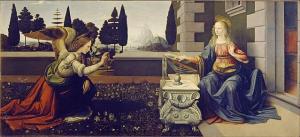
St. Raphael
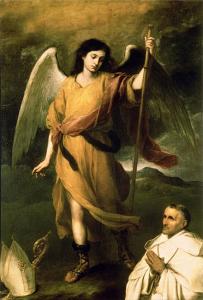
Sts. Michael, Gabriel, and Raphael, archangels Feast Sept. 29
Guardian Angels Feast Oct. 2
Learn More About Them Here…
Biblical Figures Who Lived Before The First Christmas
And Other Such Figures as
St. Elijah, St. Elisha and other Old Testament Saints
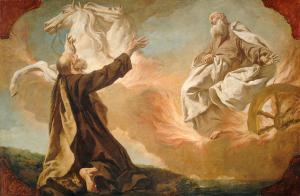
1st Millenium
Some of the Early Church Is Invoked in the Mass Each and Every Day
Eucharistic Prayer 1
* In union with the whole Church we honor Mary, the ever-virgin mother of Jesus Christ our Lord and God.
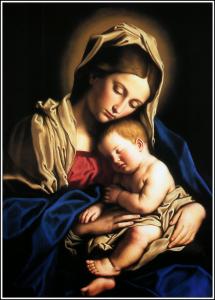
We honor Joseph, her husband,
St. Joseph, husband of the Blessed Virgin Mary Feast March 19
St. Joseph the Worker Feast May 1
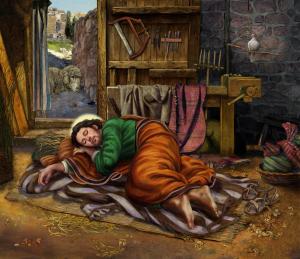

the apostles and martyrs Peter and Paul,
Sts. Peter and Paul, apostles Feast June 29
Conversion of St. Paul, apostle Feast Jan. 25
Chair of St. Peter, apostle Feast Feb. 22
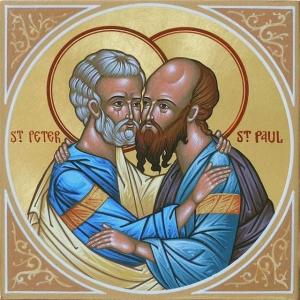
Learn More About them and other New Testament Saints Here…

Andrew, (Feast November 30)
[James, (Feast July 25)
John the apostle and evangelist (Feast December 27)
Thomas, (Feast July 3)
James and Philip (Feast May 3)
Bartholomew (Feast August 24)
Matthew (Feast September 21)
Simon and Jude (Feast October 28)

we honor Linus,
Pope # 2 St Linus (64–68 / 76–79)
Feast September 23
First Roman pope, being a Roman citizen born in Italia, the homeland of the ancient Romans.
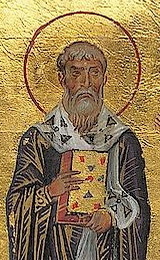
Cletus,
Pope # 3 St Anacletus (Cletus) (76–79 / 88–91)
Feast April 26
First Greek pope.
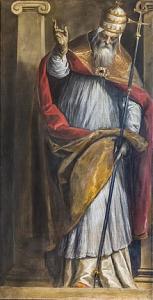
Clement,
Pope # 4 St. Clement of Rome (c. 35 AD – 99 AD)
Papal Reign – April 26, 88 –November 23, 99
(11 years, 211 days)
Apostolic Father
Feast day November 23
General Roman Calendar
Patronage of Mariners and Stone-cutters

Sixtus,
Pope # 24 St. Sixtus II
Papal Reign – August 30, 257 – August 6, 258
(341 days)
Feast August 6/7
General Roman Calendar
He was killed along with seven deacons, including Lawrence of Rome, during the persecution of Christians by the Emperor Valerian.

Cornelius,
Pope # 21 St. Cornelius
Feast day September 16
General Roman Calendar
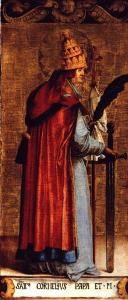
Cornelius by Master of Meßkirch
Cyprian,
St. Cyprian (ca. 210 to 14 September 258 AD)
Feast day September 16
General Roman Calendar
Patronage of North Africa, Berbers
He was a bishop of Carthage and an early Christian writer of Berber descent, many of whose Latin works are extant.
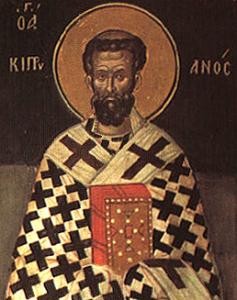
Lawrence,
St. Lawrence (December 31 AD 225 – August 10, 258)
Feast August 10
General Roman Calendar
Patronage of Cooks, Chefs, and Comedians.
As a deacon in Rome, Lawrence was responsible for the material goods of the Church and the distribution of alms to the poor. Ambrose of Milan related that when the treasures of the Church were demanded of Lawrence by the prefect of Rome, he brought forward the poor, to whom he had distributed the treasure as alms. “Behold in these poor persons the treasures which I promised to show you; to which I will add pearls and precious stones, those widows and consecrated virgins, which are the Church’s crown.” The prefect was so angry that he had a great gridiron prepared with hot coals beneath it and had Lawrence placed on it, hence Lawrence’s association with the gridiron. After the martyr had suffered pain for a long time, the legend concludes, he cheerfully declared: “I’m well done on this side. Turn me over!

Chrysogonus,
Saint Chrysogonus (Early Fourth Century)
Feast November 24
Patron Zadar
St Chrysogonus the martyr is one of the saints mentioned during the Commemoration of the Living in the Roman Canon.

John and Paul,
John and Paul – (362)
Feast June 26
The two martyr saints have been greatly venerated, and since the 5th century, their names have been included in the Roman Canon.
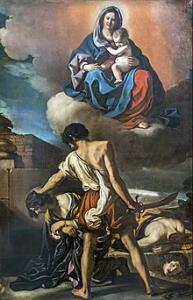
Cosmas and Damian]
Sts. Cosmas and Damian (c. 3rd century – c. 287 or c. 303 AD)
Feast September 26
General Roman Calendar
Patron of Twins and Physicians
Cosmas and Damian were third century Arabian-born twin brothers who embraced Christianity and practiced medicine and surgery without a fee. This led them to being named anargyroi (from the Greek Ἀνάργυροι, ‘the silverless’ or ‘unmercenaries‘); by this, they attracted many to the Christian faith. They reputedly cured blindness, fever, paralysis and reportedly expelled a breast serpent. They were arrested by Lysias, governor of Cilicia (modern day Çukurova, Turkey) during the Diocletian persecution because of their faith and fame as healers.
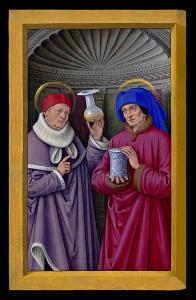
and all the saints. May their merits and prayers gain us your constant help and protection. [Through Christ our Lord. Amen.]
For ourselves, too, we ask some share in the fellowship of your apostles and martyrs,
with John the Baptist,
Feasts
Nativity of St. John the Baptist June 24
Martyrdom of St. John the Baptist Aug. 29
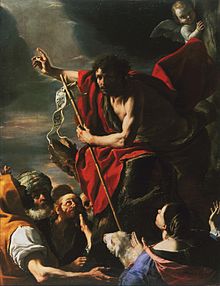
Stephen, Feast December 26
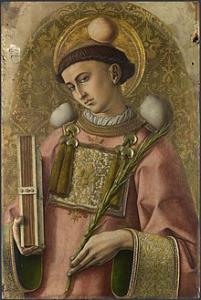
Matthias, Feast May 14
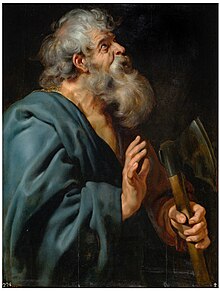
St Matthias by Peter Paul Rubens, c. 1611
Barnabas, Feast June 11
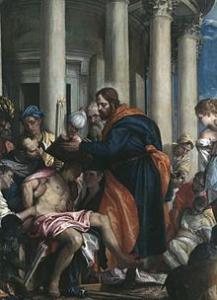
[Ignatius,
St. Ignatius of Antioch (died c. 108/140 AD)
Apostolic Father
Feast October 17
General Roman Calendar
Patronage Church in Eastern Mediterranean and The Church in North Africa
A tradition arose that he was one of the children whom Jesus Christ took in his arms and blessed.
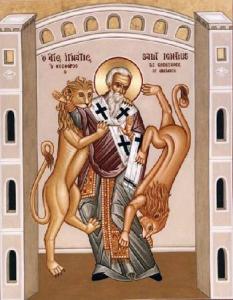
The Saint Devoured by Lions – The Story of Saint Ignatius of Antioch (youtube.com)
Alexander,
Pope # 6 St. Alexander I
Papal Reign 27 October 27, 105 – May 3, 115
(9 years, 188 days)
Feast May 3
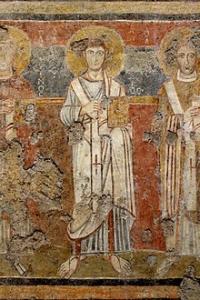
Marcellinus, Peter,
Saints Marcellinus and Peter the Exorcist (died around 304)
Feast June 2
General Roman Calendar

Felicity, Perpetua,
St. Perpetua and St. Felicity (c. 182 – c. 203)
Feast March 6
General Roman Calendar
Patrons of Mothers and Expectant Mothers
and Ranchers and Butchers
Agatha,
St. Agatha (c. 231 – 251 AD)
Feast February 5
General Roman Calendar
Patronage of Bellfounders, Breast Cancer Patients,
Bakers, and Nurses/Wet Nurses
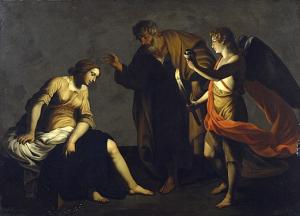
Lucy,
St. Lucia of Syracuse (283–304)
Feast December 13
General Roman Calendar
Patron of The Blind
She is one of the best known virgin martyrs, along with Agatha of Sicily, Agnes of Rome, Cecilia of Rome, and Catherine of Alexandria.
Young Christian Lucia of Syracuse (283–304) was engaged to a wealthy pagan young man which quickly ended when he denounced her to Paschasius, the Governor of Syracuse. Her betrothed didn’t much like the fact that his bride to be was distributing her family’s riches to the poor. It probably didn’t help that she wanted to remain a virgin and she was also one of those pesky annoying Christians. The Governor told her to sacrifice to the emperor’s image in which she told him to bug off. Her punishment was not at first death, that would come later when the other punishment failed to come to fruition. She was sentenced to be defiled in a brothel.
But God was having none of that. When the guards came to take her away to the house of ill repute, she couldn’t be moved by all the brute strength. She was anchored to the spot where she stood. They tried to set her on fire, but alas, that flamed out as well. Finally, they stabbed her in the throat which worked. At some point she had her eyes gorged out. What she saw that her killers didn’t see is that living for Jesus is worth living and dying for. What the whole world saw through the centuries up to the present day is an obscure young girl taken out of the shadows of life and brought to center stage as an example of a living witness of Jesus Christ by her martyrdom and commitment to Him.
Today she is known as Saint Lucy, The patron saint of people with eye problems and of writers. Sometimes God wants to make certain members of his flock an example of what He can do if we only give our whole life over to Him. He wants to show off his handy work in the lives of those we call saints. A saint can be anybody of any nationality, race, sex or age. You don’t have to be a virgin martyr like Saint Lucy or Saint Agatha who visited her in a dream to inspire her and cheer her on. Where Lucy’s eyes were gouged out, St. Agatha’s breasts were cut off with pincers.
God Exposes Young Saints | Mark Wilson (patheos.com)

Agnes,
St. Agnes of Rome (c. 291 – c. 304)
Feast January 21
General Roman Calendar
Patron of Victims of sexual abuse; Betrothed couples; Gardeners and Girl Guides
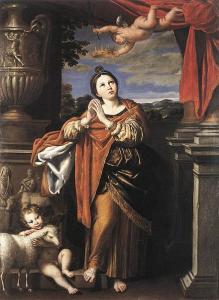
Cecilia,
Saint Cecilia (200–230 – 222–235 AD)
Feast November 22
General Roman Calendar
She became the patroness of music and musicians, it being written that, as the musicians played at her wedding, Cecilia “sang in her heart to the Lord”. Musical compositions are dedicated to her, and her feast, on 22 November, is the occasion of concerts and musical festivals.
Saint Cecilia is one of several virgin martyrs commemorated by name in the Canon of the Mass in the Latin Church. The church of Santa Cecilia in Trastevere, founded in the 3rd century by Pope Urban I, is believed to be on the site of the house where she lived and died.
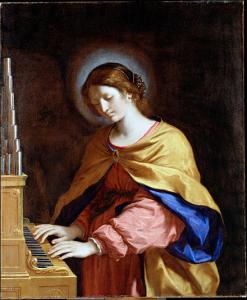
Story of Saint Cecilia | Stories of Saints for Kids | Episode 72 (youtube.com)
Anastasia]
Anastasia of Sirmium from Rome (fl. c. 304), martyr
Feast December 25
She is one of seven women who, along with Blessed Virgin Mary, are commemorated by name in the Roman Canon of the Mass.
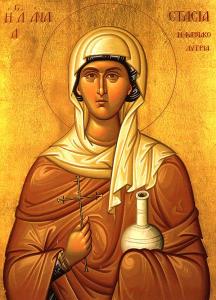
and all the saints.
Though we are sinners, we trust in your mercy and love.
Do not consider what we truly deserve, but grant us your forgiveness.
Through Christ our Lord.
Other New Testament Saints in the General Roman Calendar Include
The Gospel Writers…
St. Mark, evangelist Feast April 25
St. Luke, evangelist Feast Oct. 18
Other Biblical Characters
St. Mary Magdalene Feast July 22
Sts. Timothy and Titus, bishops Feast Jan. 26
St. Joachim & St. Anne, parents of the Blessed Virgin Mary* Feast July 26
Sts. Martha, Mary and Lazarus Feast July 29
Holy Innocents, martyrs Feast Dec. 28
Other Biblical Saints
St. Sicarius of Brantôme Feast May 2
St. Sicarius who was venerated from the time of Charlemagne onwards as one of the Holy Innocents by Herod the Great.
Saint Helen is said to have recovered the relics from the Holy Land in 328 AD. The relics were then brought to the Abbey of Saint-Pierre in Brantôme, Dordogne, by Charlemagne. Saint-Pierre had been founded by Pippin I of Aquitaine. Sicarius’ remains are stored in a small glass-and-bronze reliquary mounted on the church wall.

Saint Procla Pontius Pilate’s wife
Feast October 27 (Eastern Orthodox, Eastern Catholic)
The unnamed wife of Pontius Pilate appears only once in the Gospel of Matthew (27:19), where she intercedes with Pilate on Jesus’ behalf. It is uncertain whether Pilate was actually married, although it is likely. In later tradition, she becomes known as Procula (Latin: Procula) or Procla (Ancient Greek: Πρόκλα) and plays a role in various New Testament Apocrypha.
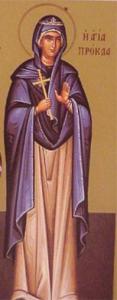
St. Dismas the Penitent Thief Feast March 25
The Penitent Thief, also known as the Good Thief, Wise Thief, Grateful Thief, or Thief on the Cross, is one of two unnamed thieves in Luke’s account of the crucifixion of Jesus in the New Testament. The Gospel of Luke describes him asking Jesus to “remember him” when Jesus comes into his kingdom. The other, as the impenitent thief, challenges Jesus to save himself and both of them to prove that he is the Messiah.
He is given the name Dismas in the Gospel of Nicodemus and is traditionally known in Catholicism as Saint Dismas
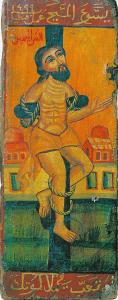
St. Longinus Feast October 16
Longinus is the name given to the unnamed Roman soldier who pierced the side of Jesus with a lance; who in medieval and some modern Christian traditions is described as a convert to Christianity. His name first appeared in the apocryphal Gospel of Nicodemus. The lance is called in Christianity the “Holy Lance” (lancea) and the story is related in the Gospel of John during the Crucifixion. This act is said to have created the last of the Five Holy Wounds of Christ.
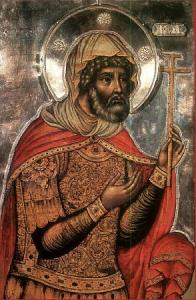
Silas – Feast July 13 (Roman Martyrology)
He was a leading member of the Early Christian community, who according to the New Testament accompanied Paul the Apostle on his second missionary journey.
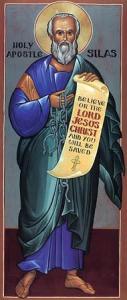
St. Simon of Cyrene Feast February 22
Simon of Cyrene was the man compelled by the Romans to carry the cross of Jesus of Nazareth as Jesus was taken to his crucifixion, according to all three Synoptic Gospels:
And as they came out, they found a man of Cyrene, Simon by name: him they compelled to bear his cross.[5]
He was also the father of the disciples Rufus and Alexander.
First African saint: St. Simon of Cyrene St. Simon of Cyrene is known to almost all Christians from his encounter with Jesus on the road to Calvary, when he was made to carry Jesus’ cross alongside him. What fewer people know is that Simon’s hometown of Cyrene was in Libya. Like the Egyptians and Libyans baptized on the day of Pentecost, and like St. Lucius of Cyrene (one of the earliest bishops in the Church, listed in Acts 13:1 as a leader in the Church at Antioch), we can’t be certain as to St. Simon of Cyrene’s race; North Africa has long been a region of great ethnic diversity, particularly at the time of the Roman occupation. But however dark their skin, these earliest Christians were Africans and stand as a reminder that the Church was thriving in Africa while England and Ireland were still untouched by the Gospel. Black saints who were “firsts” (aleteia.org)
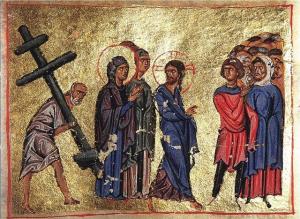
Saint Veronica Feast July 12
Saint Veronica, also known as Berenike, was a widow from Jerusalem who lived in the 1st century AD, according to extra-biblical Christian sacred tradition. According to Church tradition, Veronica was moved with sympathy seeing Jesus carrying the cross to Calvary and gave him her veil so that he could wipe his forehead. Jesus accepted the offer, and when he returned the veil the image of his face was miraculously captured on it. The resulting relic became known as the Veil of Veronica.
The story of Veronica is celebrated in the sixth Station of the Cross in Anglican, Catholic, and Western Orthodox churches.
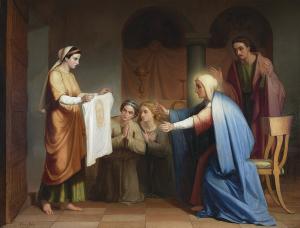
Hermione of Ephesus – Feast September 4 or April 14
Hermione was born in Cæsarea and was one of the four daughters of Saint Philip the Evangelist, one of the seven deacons as described in chapter 6 in the Acts of the Apostles, chosen by the early Christian church to minister to the community of believers in Jerusalem. Her name does not appear in the Bible, but she and her sisters are described as virgins and “gifted with prophecy.” Hermione also appears in the Menaion, the liturgical book used by the Eastern Orthodox Church. She is often confused with a daughter of St. Philip the Apostle.
According to tradition, around the early 100s, after studying medicine, Hermione travelled with her sister Eukhilda to Ephesus, through Anatolia, to meet St. John the Theologian in the hopes that they could help him in his evangelization efforts. They found that he had already died, but met Petronius, a disciple of Saint Paul, and followed him instead. Hermione became well known for her healing and built a hospital in Ephesus. She ended up dying as a martyr.

Saint Sarah Feast May 24
According to various legends, during a persecution of early Christians, commonly placed in the year 42, Lazarus, his sisters Mary and Martha, Mary Salome (the mother of the Apostles John and James), Mary Jacobe and Maximin were sent out to sea in a boat. They arrived safely on the southern shore of Gaul at the place later called Saintes-Maries-de-la-Mer. Sarah, a native of Berenice Troglodytica, appears as the black Indo-Egyptian maid of one of the Three Marys, usually Mary Jacobe.

Holy Relics
The Holy Lance, also known as the Lance of Longinus (named after Saint Longinus), the Spear of Destiny, or the Holy Spear, is alleged to be the lance that pierced the side of Jesus as he hung on the cross during his crucifixion. As with other instruments of the Passion, the lance is only briefly mentioned in the Christian Bible, but later became the subject of extrabiblical traditions in the medieval church. Relics purported to be the lance began to appear as early as the 6th century, originally in Jerusalem. By the Late Middle Ages, relics identified as the spearhead of the Holy Lance (or fragments thereof) had been described throughout Europe. Several of these artifacts are still preserved to this day.
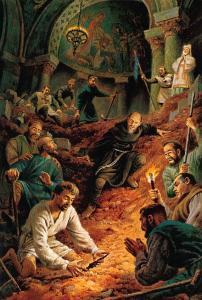
- Holy Chalice – Vessel that Jesus used at the Last Supper to serve wine. Also known as the Holy Grail
- Holy Sponge – Instrument of the Passion of Jesus Christ
- Image of Edessa – A painting of Jesus Christ’s face
- Seamless robe of Jesus – Robe said to have been worn by Jesus during or shortly before his crucifixion
- True Cross – Cross upon which Jesus was crucified
Some Biblical Fiction
Ben-Hur: A Tale of the Christ (1880) by Lew Wallace
The Robe (1942) by Lloyd C. Douglas
The Living Wood (1947) (Emperor Constantine and St. Helena) by Louis de Wohl
The Spear (1955) (St. Longinus) by Louis de Wohl


